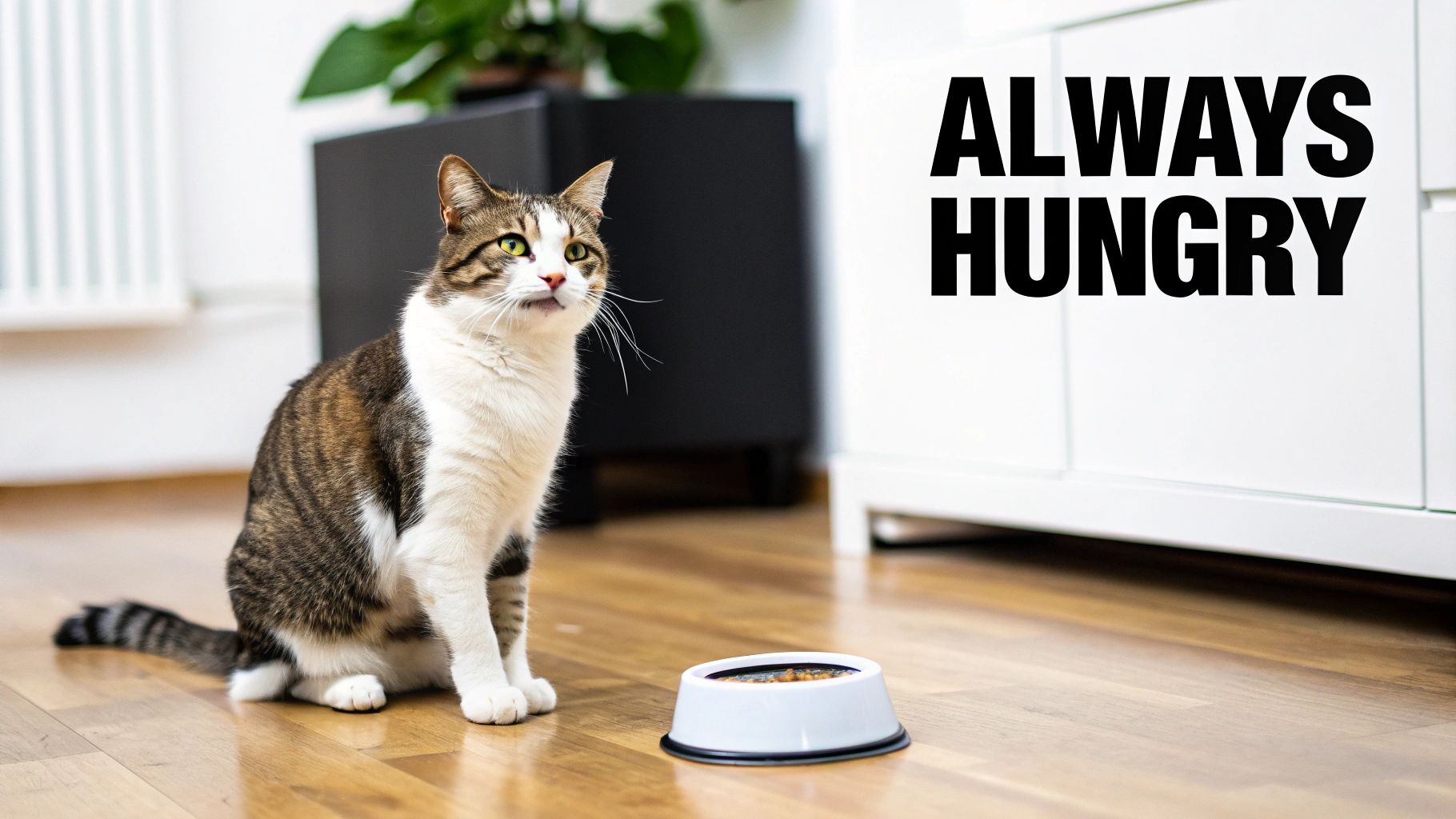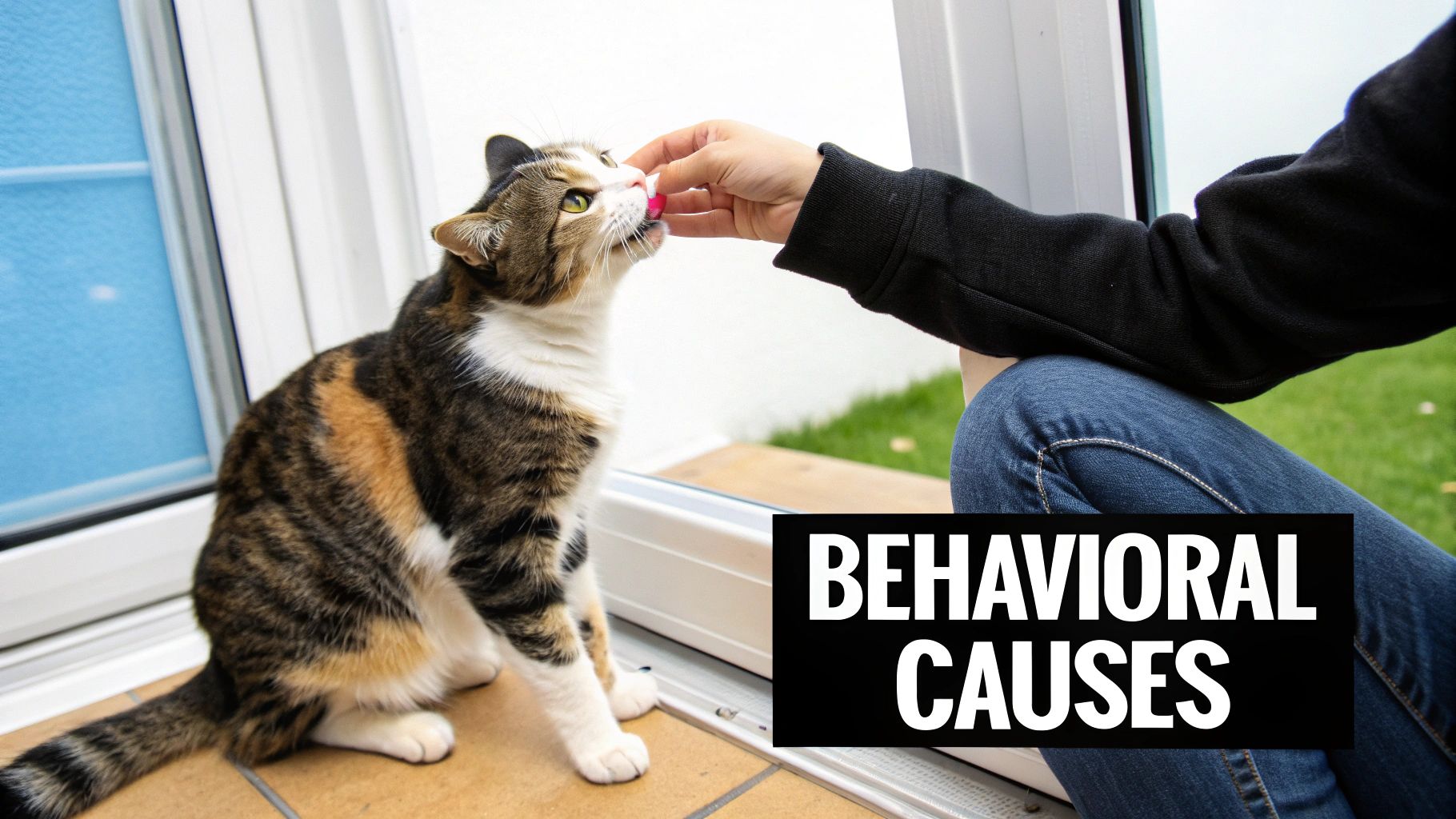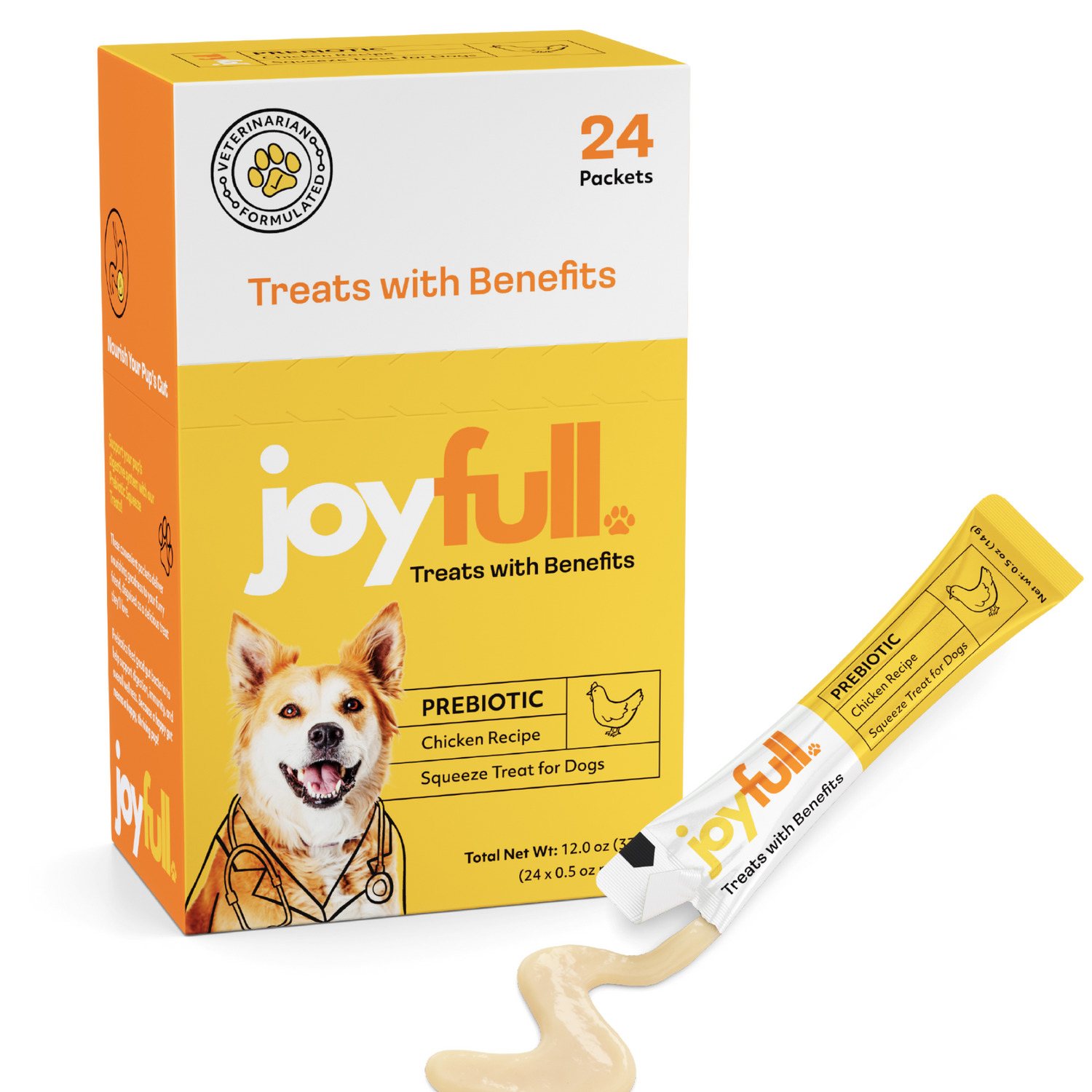
why is my cat always hungry: Top causes and quick fixes
If you've ever found yourself wondering, "Why is my cat always hungry?"—you're definitely not alone. A cat that seems perpetually starved, a condition known as polyphagia, isn't usually just being greedy. More often than not, it's a sign that something else is going on under the surface. The culprit could be anything from a medical issue like hyperthyroidism to a nutritional shortfall in their diet or even a simple case of boredom.
Why Your Cat Seems to Be Starving All the Time

This guide is here to help you translate what your cat is trying to tell you, so you can stop worrying and start taking action. Think of your cat's ravenous appetite as a coded message. Your job is to crack that code, and it could be pointing to one of several different issues.
This is a familiar concern for a growing number of people. As cat ownership has climbed from 23.6% of households in 2019 to 27.3% more recently, it means over a quarter of homes now have a feline friend. With more cats in our lives, we're becoming much more attuned to their behaviors, especially their eating habits. You can dig deeper into these pet ownership trends on PetfoodProcessing.net.
To give you a clearer picture, we've put together a quick-reference table summarizing the potential causes.
Quick Guide to Potential Causes of Your Cat's Hunger
This table breaks down the common reasons a cat might seem overly hungry, helping you start to connect the dots between their behavior and what might be causing it.
| Category | Potential Cause | Key Symptoms to Watch For |
|---|---|---|
| Medical | Hyperthyroidism | Weight loss despite a huge appetite, hyperactivity, vocalizing. |
| Medical | Diabetes Mellitus | Increased thirst and urination, weight loss, lethargy. |
| Medical | Intestinal Parasites (Worms) | Potbelly appearance, poor coat condition, visible worms in stool. |
| Nutritional | Low-Quality or Inappropriate Diet | Dull coat, low energy, digestive upset, craving non-food items. |
| Behavioral | Boredom or Lack of Stimulation | Pestering for food when not hungry, attention-seeking. |
| Behavioral | Stress or Anxiety | Overeating as a coping mechanism, hiding, changes in litter box habits. |
This isn't a diagnostic tool, of course, but it's a great starting point for observing your cat more closely before talking to your vet.
Decoding the Signals Behind Their Appetite
To really get to the bottom of your cat’s insatiable appetite, it helps to group the potential culprits into three main buckets:
-
Medical Conditions: These are health problems that throw your cat's metabolism out of whack or prevent them from properly absorbing nutrients, which tricks their brain into thinking they're still hungry.
-
Nutritional Deficiencies: The food in their bowl might be filling their stomach, but if it lacks the right nutrients, their body will keep sending out hunger signals. It's like eating junk food—you feel full for a minute, but you're not truly nourished.
-
Behavioral Triggers: Sometimes, the "hunger" is all in their head. Things like boredom, stress, or even habits learned over time can drive a cat to constantly meow for more food.
A cat's relationship with food is incredibly complex. A sudden increase in appetite isn't always about hunger; it can be a symptom of a physiological need, a cry for mental stimulation, or a response to an internal imbalance.
Thinking about the problem in these categories gives you a solid framework for your investigation. We'll walk through each one, helping you pinpoint why your cat is acting like a bottomless pit and what you can do about it.
Ruling Out Underlying Medical Conditions
Before you write off your cat's constant begging as just a quirky habit, it's crucial to make sure there isn't a medical issue at play. A sudden, ravenous appetite can be one of the first clear signs that something is wrong internally. Ignoring this red flag could mean overlooking a serious condition that needs a vet's attention.
Think of your cat's metabolism like a car engine. Normally, it hums along at a steady pace. But certain health problems can jam the accelerator, causing the engine to burn through fuel way too fast and demand more, more, more.
Hyperthyroidism and Diabetes Mellitus
Two of the most frequent offenders behind a perpetually hungry cat are hyperthyroidism and diabetes mellitus. While they're different diseases, both mess with how your cat’s body uses energy, which can crank their appetite up to eleven.
-
Hyperthyroidism: This is a common issue in senior cats. The thyroid gland goes into overdrive and pumps out too much hormone, sending their metabolism into a frenzy. They're burning calories so quickly that even though they're eating you out of house and home, they often start losing weight. It's like their internal engine is stuck in fifth gear.
-
Diabetes Mellitus: With diabetes, the body either can't produce enough insulin or can't use it properly. Insulin is the key that lets sugar (glucose) from food enter the body's cells to be used for energy. Without it, the sugar just builds up in the blood while the cells starve. Your cat's brain gets a constant, frantic signal: "We need fuel!" even right after a big meal.
A huge red flag for a medical problem is weight loss despite a bigger appetite. If your cat is eating more than ever but is still getting thinner, that's your cue to call the vet right away.
Intestinal Parasites and Malabsorption Issues
Sometimes, the problem isn't about how the body is using the food, but whether it's even getting the nutrients in the first place. Unwanted guests or a faulty digestive system can leave your cat feeling famished because they simply aren't absorbing what they eat.
Intestinal parasites like roundworms or tapeworms are a classic example. These critters set up shop in your cat’s digestive tract and literally steal nutrients from their food. Your cat eats a perfectly good meal, but the worms get a hefty share, leaving your poor kitty feeling empty and undernourished.
Other conditions, like Inflammatory Bowel Disease (IBD), can also be the culprit. IBD causes chronic inflammation that damages the lining of the intestines, making it tough for your cat to absorb nutrients properly. This poor absorption, known as malabsorption, tells the brain to keep asking for more food to make up for what's being lost. Malabsorption can sometimes be linked to food sensitivities; you can learn more about the common signs of food allergies in cats. Ultimately, only a proper veterinary diagnosis can pinpoint the problem and get your cat on the right treatment plan.
How Your Cat's Diet Can Create Hunger

The food you put in your cat’s bowl does a lot more than just fill their belly. It’s sending constant signals to their brain and body about whether they’re truly nourished or just temporarily full. If your cat acts like a bottomless pit, their diet might be the very thing creating that frustrating cycle of meowing, begging, and dissatisfaction.
It all comes down to a simple biological fact: cats are obligate carnivores. That’s a fancy way of saying their bodies are hardwired to run on animal-based protein. When their food is packed with fillers like corn, wheat, or soy instead of high-quality meat, it’s like trying to fuel a race car with cheap, watered-down gas. Their stomach might feel full, but their body knows it’s missing what it truly needs, and it will keep sending out hunger signals.
The Problem with Carbs and Fillers
Look at the ingredients on a bag of dry cat food, and you’ll often find it’s loaded with carbohydrates. These are needed to hold the kibble bits together, but a high-carb diet sends a cat’s body on a wild ride. It causes a rapid spike in their blood sugar, followed by a sudden crash.
That crash is what leaves them feeling ravenous again, sometimes just an hour after eating. So, when your cat polishes off a bowl and is immediately back for more, they aren't just being greedy. Their body is genuinely telling them it needs a more stable source of energy.
A diet that fails to provide biological satisfaction will always leave a cat feeling hungry. The key is to feed them in a way that aligns with their carnivorous nature, focusing on high-quality animal protein and moisture content to promote satiety.
The pet food industry is a massive one, with global sales hitting around $133.9 billion. And while there’s been a great push toward better ingredients, many cats still act like they're starving. This tells us that it’s not just about what’s in the food, but how it all comes together to meet their unique needs.
Wet Food vs. Dry Food for Satiety
One of the most powerful changes you can make is to introduce more wet food. Canned or pouched food is almost always higher in protein and lower in carbohydrates than the average dry kibble.
Even more importantly, it's packed with moisture. All that water adds weight and volume to their meal without adding extra calories, helping to physically fill up their stomach. This simple switch can leave your cat feeling satisfied for much longer and keeps them better hydrated, too.
Learning how to choose the right cat food is the first step to getting their appetite under control. A good place to start is by looking for a food that contains:
- Named animal protein as the very first ingredient (like chicken, turkey, or salmon).
- Low carbohydrate content to keep blood sugar levels stable.
- Sufficient fiber to help them feel full and support healthy digestion.
By really understanding what's going into their bowl, you can finally tackle the nutritional root of your cat's constant cries for more food.
Once you've ruled out medical problems and made sure your cat's diet is hitting all the right nutritional notes, it's time to look at a different culprit: their state of mind. Sometimes, the real answer to "why is my cat always hungry?" isn't in their belly, but in their brain. Behavioral and psychological factors are powerful drivers that can turn a perfectly well-fed cat into a relentless food-seeker.

Think about it this way: people often snack when they're bored or stressed, and our feline friends are no different. A cat living in a dull, under-stimulated home with nothing to hunt, climb, or explore might just turn to the food bowl for a bit of excitement. When eating is the most interesting part of their day, they're naturally going to ask for it all the time.
Learned Behavior and Pestering for Attention
Cats are wickedly smart, and they learn cause and effect in a flash. If your cat meows, weaves through your legs, or gives you that intense stare and you immediately offer a treat or top off their bowl... well, you've just taught them that this routine works. Congratulations, your cat has successfully trained you.
This kicks off a powerful cycle where what looks like "hunger" is actually a learned behavior to get your attention, one they know will be rewarded with food. It’s a habit that can be surprisingly tough to break. This is made even more common by our modern pet culture, where we love to treat our pets, sometimes accidentally encouraging this very behavior. You can dive deeper into how pet-keeping culture influences feeding habits on PetfoodIndustry.com.
Boredom and Stress Eating
A stimulating environment isn't just a "nice-to-have" for a cat; it's essential for their mental health. Nine times out of ten, a bored cat is a "hungry" cat. Without enough puzzles to solve or things to chase, they might fixate on food as their only source of fun and engagement. This is where environmental enrichment can be an absolute game-changer.
Boredom is the silent culprit behind so many feline behavior issues, including overeating. When a cat can't satisfy its natural instincts to hunt, stalk, and play, that pent-up energy often gets redirected straight to the food bowl.
Stress and anxiety can also show up as a bigger appetite. Big life changes like a new pet, a move to a new house, or even a shift in your daily routine can make a cat feel insecure. For some, overeating becomes a way to self-soothe.
So, how do you fix hunger that isn't really hunger? It's all about making their world more interesting and secure.
Boredom Busters vs. Feeding Fixes
Sometimes it's tricky to tell if your cat's behavior is stemming from a boring environment or a diet that's leaving them unsatisfied. Here’s a quick guide to help you distinguish between the two and find the right solution.
| Symptom | Potential Behavioral Cause | Behavioral Solution | Potential Dietary Cause | Dietary Solution |
|---|---|---|---|---|
| Pestering between meals | Your cat has learned that begging gets them attention (and food). | Ignore the begging, but initiate play sessions instead. | The food isn't satisfying; it might be low in protein or fiber. | Switch to a high-protein, low-carb wet food or a high-fiber formula. |
| Eating very quickly | Boredom or anxiety; eating is the most exciting event of the day. | Use puzzle feeders to slow them down and engage their brain. | The cat feels insecure about its food source (common in multi-cat homes). | Provide separate, safe feeding stations for each cat. |
| Waking you up for food | The cat is bored overnight and knows this gets a reaction from you. | Schedule a vigorous play session right before bed. | A long overnight fast leaves them genuinely hungry by morning. | Offer a small, protein-rich snack before you go to sleep. |
| Obsessive focus on the food bowl | Lack of other stimulation; the food bowl is the center of their world. | Increase environmental enrichment with cat trees, toys, and window perches. | Meal portions might be too small for their activity level or metabolism. | Re-evaluate their daily caloric needs with your vet. |
By observing when and why your cat is asking for food, you can get a much clearer picture of what they truly need—whether it’s more playtime or a different dinner plan.
Key Solutions for Behavioral Hunger:
- Puzzle Feeders: These brilliant toys make your cat "hunt" for their food. This engages their brain, slows down their eating, and satisfies that instinct to work for a meal.
- Scheduled Playtime: Don't just wait for your cat to get bored. Proactively schedule at least 15-20 minutes of interactive play twice a day. A good session with a wand toy can tire them out and curb food-seeking.
- Go Vertical: Cats feel safer and more confident when they can survey their territory from up high. Cat trees, wall shelves, and window perches are fantastic for reducing stress-related eating habits.
By tackling these psychological root causes, you can often transform a cat that seems to be starving into one that is happy, content, and perfectly balanced.
Actionable Steps to Manage Your Cat's Appetite
Alright, you've got a good handle on why your cat might be acting like a bottomless pit. Now, let's get to the good stuff: what you can actually do about it. By making a few smart adjustments to their daily life, you can get a grip on that constant hunger, cut down on the incessant begging, and help them feel genuinely satisfied after a meal.
Think of it as hitting the reset button on your cat's relationship with food. We're not just trying to quiet the meows; we're aiming to meet their deep-seated needs for routine, mental exercise, and the right kind of nutrition. This whole process helps get their metabolism back on track and recalibrates their expectations around feeding time.
Establish a Consistent Feeding Schedule
One of the single best things you can do for a perpetually hungry cat is to stop free-feeding. Seriously. Leaving a mountain of kibble out 24/7 is a recipe for overeating and it completely scrambles their natural hunger signals. The solution? Scheduled mealtimes.
- Create a Routine: Cats are creatures of habit. Feeding them two or three measured meals at the exact same times every day gives them a sense of predictability. Their bodies learn to anticipate food, which can help regulate their metabolism.
- Measure Portions Precisely: Don't just eyeball it. Grab a proper measuring cup and serve the exact amount recommended for their age, weight, and activity level. This is crucial for avoiding the accidental over- or under-feeding that can make them feel constantly starved.
Make Mealtime an Engaging Challenge
Out in the wild, dinner doesn't magically appear in a ceramic bowl. Cats have to work for it—they have to hunt. We can tap into that powerful instinct right in our living rooms to slow down speedy eaters and give their brains a much-needed workout. This kind of enrichment is fantastic for curbing those food-obsessed behaviors that are often just a cry of boredom.
An easy and incredibly effective way to do this is with a puzzle feeder. These are toys that make your cat bat, paw, and problem-solve to get a few kibbles out at a time. It turns a two-minute chow-down into a longer, more engaging activity, leaving them feeling calmer and far more content.
Turning mealtime from a two-minute gorge into a 20-minute "hunt" satisfies your cat's innate predatory drive. This simple change addresses the behavioral roots of hunger, making them feel more fulfilled both mentally and physically.
Optimize Their Diet for Satiety
The food you choose plays a massive role in how full your cat feels. A diet built around high-quality animal protein and moisture is the ticket to lasting satisfaction. If their current food is loaded with carbs, it could be causing energy spikes and crashes that leave them feeling hungry again almost immediately.
For a deeper dive into this, check out our guide on choosing a cat food with high protein to make sure you're hitting all their nutritional marks.
Putting these practical steps into place can completely reshape your cat's connection with food. The end result is a happier, healthier companion—and a much more peaceful home for both of you.
Knowing When to Consult Your Veterinarian
It’s one thing to manage a cat who’s just a bit of a glutton, but it's another thing entirely when their insatiable appetite is a sign of something more serious. While you can handle many food-related quirks with a few adjustments at home, some symptoms are your cat's way of sending up a flare.Knowing when to call the vet is crucial. Think of it as your cat’s body sending an urgent distress signal. Picking up on these clues and acting fast ensures they get the professional help they need right away.
Critical Signs Demanding a Vet Visit
If your cat's bottomless appetite comes with any of the symptoms below, don't wait. It’s time to book a vet appointment immediately. This combination of signs often points to serious conditions like hyperthyroidism, diabetes, or other health problems that need a proper diagnosis and a treatment plan.
-
Rapid weight loss despite eating more: This is the big one. If your cat is eating you out of house and home but is still getting thinner, it’s a classic sign their body isn't absorbing or using the nutrients from their food correctly.
-
Excessive thirst and urination: Are you constantly refilling the water bowl? Is the litter box always soaked? This could signal diabetes or kidney issues.
-
Vomiting or diarrhea: When an increased appetite is paired with persistent digestive upset, it can suggest malabsorption problems or even Inflammatory Bowel Disease (IBD).
-
Sudden lethargy or hyperactivity: Any dramatic shift in your cat’s normal energy levels—either becoming sluggish or suddenly bouncing off the walls—is a major cause for concern.
This infographic breaks down a simple process for figuring out what to do about your cat's appetite.

As you can see, a solid routine is your first line of defense. Things like scheduled meals, measured portions, and mental stimulation are fundamental to keeping your cat’s appetite in a healthy place. These at-home strategies build a great foundation, but they are no substitute for a professional vet visit when those serious symptoms pop up.
Frequently Asked Questions
Even after you've done your research, some specific questions always seem to come up when you're dealing with a constantly hungry cat. Let's tackle some of the most common ones I hear from cat owners.
Is My Cat Just Bored With Their Food?
It's a common thought, but what we often label as "boredom" is usually a sign that their diet is missing the mark. Cats are obligate carnivores, meaning they're built to thrive on meat.
If their food is packed with fillers and low on high-quality animal protein, they'll feel hungry again soon after eating simply because their fundamental nutritional needs aren't being met. Before you start rotating through every flavor on the shelf, try switching to a high-protein, low-carb diet. This is what truly keeps a cat feeling full and satisfied. You can also make mealtimes more stimulating by using a puzzle feeder.
My Vet Says My Cat Is Healthy, So Why Are They Always Begging?
If you've gotten the all-clear from your vet and you're feeding a high-quality diet, then you're almost certainly dealing with a learned behavior. Cats are smart. Your little genius has figured out that a certain meow, a persistent stare, or a leg-rub is the magic button that produces a treat.
Breaking this habit requires consistency.
- Don't reward the begging. This is the hardest part, but you can't give in, no matter how cute or pathetic they seem.
- Stick to a strict meal schedule. This helps them understand that food only arrives at specific, predictable times.
- Redirect their focus. When the begging starts, grab a wand toy or offer some pets instead of a snack.
It takes patience, but eventually, your cat will learn that the "begging button" is broken. You're not being mean; you're just resetting their expectations.
Is It Normal For Kittens and Senior Cats to Be Hungrier?
Absolutely. A cat's appetite naturally changes with age. Kittens are tiny growth and energy machines, so it’s no surprise they often seem to have a bottomless stomach.
For senior cats, it's a bit more complicated. While some seniors eat less, others develop age-related health issues like hyperthyroidism or diabetes, which can crank their hunger into overdrive. Any sudden, dramatic increase in an older cat's appetite is a clear signal to schedule a vet visit right away to get to the bottom of it.
At Joyfull, we believe your pets deserve clean ingredients and high-quality proteins that truly nourish them. Explore our scientifically reviewed formulas to find the perfect fit for your feline friend. Discover better-for-you pet wellness at Joyfull.

